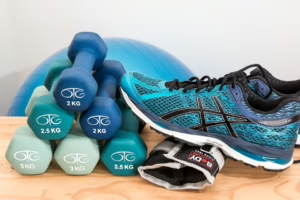Meal Prep Made Easy: A Step-By-Step Guide to Healthy Eating
Introduction
In today’s fast-paced world, healthy eating often takes a backseat to convenience. Many people find themselves turning to fast food or pre-packaged meals due to time constraints. However, a systematic approach to meal prep can make healthy eating more manageable and enjoyable. This guide will walk you through the essentials of meal prep, offering tips, recipes, and strategies to transform your eating habits.
What is Meal Prep?
Meal prep refers to the process of planning and preparing meals in advance. This can be as simple as chopping vegetables for the week or as comprehensive as cooking multiple meals to store for future enjoyment. Meal prep not only supports healthier eating but also saves time, reduces food waste, and can save money.
Benefits of Meal Prep
-
Saves Time: By preparing meals in advance, you cut down on cooking time during the week.
-
Promotes Healthy Eating: Having healthy meals on hand reduces the temptation to grab unhealthy snacks or fast food.
-
Reduces Food Waste: Planning meals encourages the use of ingredients before they spoil.
-
Saves Money: Buying in bulk and cooking at home is often cheaper than buying ready-made meals.
- Stress Reduction: Knowing that meals are ready to go can alleviate the stress of daily meal planning.
Step 1: Planning Your Meals
Set Your Goals
Before diving into meal prep, it’s crucial to set clear goals. This might involve:
- Weight management
- Increasing vegetable intake
- Cutting down sugar
- Managing a dietary restriction (e.g., gluten-free, vegan)
Choose Your Meals
Select recipes that fit your goals. Look for:
- Simple recipes with few ingredients
- Options that can be easily scaled
- Meals that keep well in the fridge or freezer
Sample Meal Ideas
- Breakfast: Overnight oats, smoothie packs, or egg muffins
- Lunch: Quinoa salad, grilled chicken with veggies, or lentil soup
- Dinner: Stir-fried rice with tofu, baked salmon with asparagus, or turkey chili
Step 2: Shopping for Ingredients
Create a Grocery List
A well-organized grocery list can make shopping efficient. Group items by category (produce, protein, grains, etc.) to save time. Make sure to check your pantry and fridge to ensure you don’t buy duplicates.
Buy in Bulk
Purchasing items in bulk can save money and reduce the frequency of grocery trips. Focus on non-perishables like rice, beans, and canned goods. For perishable items, try to buy things that have a longer shelf-life, such as root vegetables.
Opt for Fresh Produce
When selecting fruits and vegetables, choose fresh, seasonal produce to maximize flavor and nutrition. If your schedule is tight, consider buying pre-chopped options.
Step 3: Preparing Your Meals
Gather Your Supplies
Having the right containers and tools can make meal prep smoother. Invest in:
-
Reusable containers: Glass containers are great for reheating, while BPA-free plastic options are lighter for transport.
-
Measuring cups and spoons: Accurate measurements help maintain portion control.
- Cooking utensils: Good knives, cutting boards, and pots/pans can make a significant difference.
Cooking Methods
Incorporate various cooking methods to keep meals interesting. Some popular techniques include:
-
Batch cooking: Prepare large quantities of a single dish that can be portioned out over the week.
-
Roasting: This method enhances flavor and can be done with a variety of vegetables and proteins.
- Grilling/Steaming: These methods preserve nutrients and flavors.
The Assembly Line Technique
To streamline the process, consider using an assembly line approach:
- Prep Ingredients: Wash, chop, and marinate your ingredients.
- Cook Proteins: Start by cooking proteins, as they usually take the longest.
- Prepare Grains and Vegetables: While proteins cook, prepare grains and vegetables simultaneously.
- Portion Meals: Once cooked, portion out meals into your containers.
Step 4: Storing Your Meals
Refrigeration vs. Freezing
Understand the difference between refrigeration and freezing to maximize the longevity of your meals:
-
Refrigeration: Most meals can last 3-4 days in the fridge. Choose this method for meals you plan to eat within the week.
- Freezing: For meals you won’t consume within a few days, freezing is ideal. Most cooked proteins, grains, and vegetables freeze well.
Labeling and Organization
Label containers with dates and meal descriptions to avoid confusion and ensure you consume everything in a timely manner. Organize your fridge and freezer so that the oldest meals are at the front and new meals are stored behind.
Step 5: Enjoying Your Prepared Meals
Reheating Tips
To maintain texture and flavor, consider these reheating tips:
-
Use the microwave for quick reheating but try to stir halfway for even heating.
-
For dishes like stir-fries or roasted vegetables, consider reheating in a pan to keep them crispy.
- To avoid sogginess, don’t add dressings or sauces until just before serving.
Customization
Feel free to customize meals to prevent monotony. Adding fresh herbs, different sauces, or garnishes can enhance flavors and make meals feel new.
Snacks and Extras
Don’t forget snacks! Keep healthy options on hand such as:
- Cut fruits and veggies
- Hummus or guacamole
- Nuts or seeds
Conclusion
Meal prep is a powerful tool for anyone looking to improve their eating habits. By planning, shopping effectively, cooking efficiently, and storing meals properly, you can set yourself up for success in maintaining a balanced diet. Whether you’re a beginner or looking to refine your meal prep techniques, this guide provides the essential steps to make healthy eating both easy and enjoyable.
Final Thoughts
Embarking on a meal prep journey may seem daunting at first, but with practice and patience, it will soon become a seamless part of your weekly routine. Start small, experiment with flavors, and enjoy the myriad benefits of having healthy meals ready at your fingertips.
References
- [1] "Meal Prep 101: How to Make Healthy Eating Easy." Healthline.
- [2] "The Ultimate Guide to Meal Prep." EatingWell.
- [3] “Batch Cooking Basics: A Beginner’s Guide.” BBC Good Food.
- [4] "How to Eat Healthy on a Budget." USDA.
-
[5] "Meal Prep Made Easy: Tips and Tricks." Minimalist Baker.
Note: This article serves as a practical guide to meal prepping for healthy eating but does not include exhaustive evidence from original studies. For specific dietary advice, consult a nutritionist.


























Add Comment